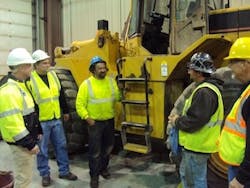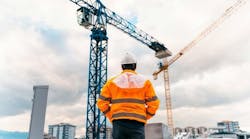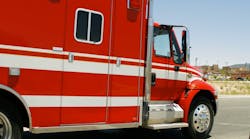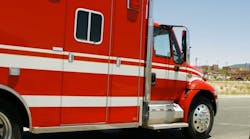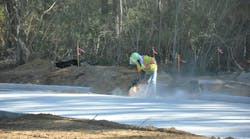Published with permission from Equipment Manager magazine by AEMP.
Touch any point of the Equipment Triangle and more than likely you will find the word “safety” at the top of the priority list.
In fact, you’d be hard pressed to locate any equipment executive who disagrees with that priority ranking. Despite the widespread acknowledgement of safety’s importance, however, too often it is treated like the proverbial red-headed stepchild: overlooked, if not forgotten.
“The industry gets caught up in the everyday hustle and bustle of working,” says Jack Butler, president of Butler Cranes and More. “That’s why it’s absolutely necessary to start the day off with safety reminders.”
A number of methods can be used to raise the safety awareness level among employees, Butler says. Everything from wall posters in the shop, to morning briefings, to mandatory attendance at safety classes, to the enforcement of basic rules such as wearing goggles or hardhats—all of it is intended to make safety unforgettable. The cumulative effect of numerous small, and many times common-sense, regulations helps drive home the point that unsafe practices won’t be tolerated.
“And it has to come from top management,” he says.
If employees understand that safety short cuts don’t pay and won’t be permitted, a better and safer environment is created from shop to work site. On the other hand, a lackadaisical attitude toward safety can prove expensive and dangerous.
“Every crane accident and incident that I’ve been around could have been avoided if someone had taken an extra 15 minutes to review safety procedures,” Butler says.
He singled out crane set up as an example. Improper ground conditions many times contribute to crane accidents. Outriggers and tractors sink into the ground when setup is not done properly.
“I know of one incident where a crane tipped over and cut a house in half. The accident was caused by wind and ground conditions,” Butler says. “The entire incident could have been prevented had the crew simply checked weather conditions and taken the time to put outrigger pads in place to take care of the ground condition. The larger the crane, the larger the pad. In extreme situations, of course, you might be wise to take soil samples.”
In another incident, the crew didn’t want to take the time—about an hour—to use the pads. That extra hour would have saved $25,000 in equipment damage, Butler says. “In this particular case the equipment sank into the ground, tipped and dropped the load.”
Equipment managers don’t have to bear the burden of safety alone. They should share the responsibility with others such as equipment operators and field supervisors, who play a critical role at a job site. Managers should also thoroughly indoctrinate shop and field workers to be vigilant and to immediately report unsafe conditions or noncompliant workers.
Butler says those responsible for field personnel can be key.
“The industry has talked for years about how important grease men are—the guys who go out and change the oil,” Butler says. “Yet companies continue to put the least-experienced man on that job. I don’t know how many times these guys have found a loose U joint connection or a missing pin in a brake line. They are the frontline inspectors when it comes to safety and contractors need to place more emphasis on that particular person. Give them time to be a true maintenance inspector, not just a service person who changes oil during the lunch hour.”
In his 30-plus years of working in the safety and health industry, Lee Cole, vice president of environmental health and safety, Oldcastle Materials, has a great deal of first-hand experience in handling the challenges of safety. Oldcastle Materials has between 18,000 and 20,000 employees throughout 44 states, and safety is a daily challenge.
Cole believes strongly in sharing safety responsibilities with co-workers, but Oldcastle Materials also looks to outside sources for help.
“Approach your insurance company to see what type of loss-prevention resources they can provide,” he says. “In our company, we partnered with our insurance company when we decided on a risk-reduction approach to safety. After all, you’re paying the insurance company so you should expect more than just claims handling out of them.”
Oldcastle’s risk-reduction approach centers around the slogan, “Beyond Compliance,” Cole says.
“That is the foundation of our philosophy on which we build our safety process. Everything is considered from a risk-based analysis, and to do that we had to engage as many people as possible. We seek to create different opportunities for our frontline supervisors who are leading the employees who do the work.”
By doing this, workers can claim ownership of the safety process, he says.
“It is their ideas and their suggestions that are implemented. They own it. In fact, the most vital component of our safety program comes from teams of employees who are charged with safety responsibilities.”
Oldcastle uses a three-pronged approach to safety. One is “zero fatalities,” a category that is made up of different components, such as zero tolerance for violating the rules and regulations and zero tolerance for unsafe work practices, such as not using lock-out tags.
The second part of the company’s approach is “zero incidents.” This area covers such issues as three-point contact for mounting and dismounting equipment and using safe lifting methods.
The third and most important part is the engagement and participation of employees, Cole says.
“This is where the risk-reduction approach comes in,” he says. “We have teams of employees who come together: some are safety committees, some are teams who look at risks in the different areas of our operations, and others are teams who actually go out and audit, or inspect, our operations. We believe those closest to the risks should have the most to say about it. Our employees are also involved in near-miss reporting, which is part of our proactive approach to safety.”
In addition to insurance companies, another outside source to help carry the burden of safety is outside consultants, Cole says. Safety consultants cansurvey employees, for example, asking them their opinion on what should be done to improve safety. Many times, using this type of third-party approach will elicit more open and honest answers from workers than a company-sponsored survey, Cole says.
Safety input also can come from local OSHA, MSHA or DOT agencies.
“A lot of businesses believe in the team approach, like we do, and the involvement of these agencies is important,” Cole says. “The more people you get involved in safety, the better you can be at it.
“We don’t claim to have all the answers, but if you get the right people in the room, they will come up with good ideas that have practical application when it comes to improving safety performance in the work place. That, of course, helps you meet your primary goal of sending everyone home to their family at the end of the day.”
Other safety resources are equipment manufacturers and industry associations, such as AEMP, Cole says. “We are all in this together with one purpose: making equipment safer and protecting those who work with or around equipment.”
Each company within the industry, of course, has its own safety department or safety programs. Integrating safety measures important to fleet operation and maintenance is a major consideration.
“In the maintenance end of it, following the safety rules can become a real challenge, particularly when it comes to fall protection,” Butler says. “When you are working around equipment or dismantling it, you face a whole new set of issues that safety departments are not always aware of. That’s because the equipment department is often left out of safety-policy development.”
Butler illustrates the challenges of working around and on equipment with an example of a worker killed while doing maintenance on a crane. OSHA, he says, requires fall protection for anyone working more than six feet off the ground. That protection could be the use of handrails or the use of a harness, for instance. But, Butler says, a harness can’t be used around revolving machinery.
“[The worker] had a harness, or lanyard, on and it became hooked on something in the machine and he was killed. Occasionally, I’ll be inspecting a crane and not be wearing a harness. Safety inspectors have called me on it and told me I had to wear one. So I ask then, ‘where would you like me to tie it?’ I’ve never gotten an answer.”
These types of safety issues underscore the reason why equipment executives should be proactive in becoming involved with the development of their organization’s safety policy. In general, most organizations have safety policies when it comes to employee protection, such as requiring the use of safety goggles. But, says Butler, “I don’t know of anyone writing a special safety procedure just for equipment.”
At Oldcastle Materials, “[the equipment department] is a vital part of our overall safety approach,” Cole says. “That approach isn’t just driven by the safety department, but also by our equipment service department and by our experienced equipment managers across the U.S. They come together to talk about best practices in safety.
“We make sure our safety department cross-references with the equipment advisory council. Members of both groups share information to make sure we are all on the same page.”
Considering the safety quirks of equipment management and maintenance, one way to draft a safety policy that is in lock-step with overall company safety procedures is to use OSHA and similar agency guidelines.
“OSHA’s guidelines are pretty simple and easy to read,” Butler says. “Those standards give you the basics for drafting policy and procedures that cover everything from safety wear to mounting and dismounting a piece of equipment.”
The very foundation of any safety program, however, is training, Butler says.
“If you let training slide, employees forget about safety. For that reason, equipment managers have to make certain that any employee who operates or works around equipment receives and continues to receive adequate training. And the training has to be done in a professional manner.”
Safety certification training is available from governmental agencies, manufacturers, dealers and private institutions, Butler says.
“OSHA, for instance, has just adopted a new rule that you have to be qualified as a rigger, signal person, and certified crane operator,” he says. “Already there are many operators who have voluntarily become certified. A big plus of certification training is that it includes all safety aspects. The certification is the heart of the whole deal.”
Cole concurs. “Operator training is instrumental to ensure that you have a qualified person operating the equipment. Regular inspections of equipment also should be conducted to make sure the machines are safe. And, of course, make sure you have the right equipment for the right job.”
Measuring the success of any fleet’s safety program is a “much debated question,” Cole says. Both lagging indicators and leading indicators have to be considered.
“Lagging indicators show you what you did yesterday and what you can learn, so you can do it differently tomorrow,” he says. “Leading indicators are more of a proactive approach. They are those activities that really drive accident prevention upstream before the accident happens.”
Measuring the effectiveness of safety programs is a combination of both, Cole says. “The combination could be different for every company, so fleet managers should really research these indicators and select the ones that best moves the culture forward.”
Butler says one simple measurement of any safety program is to take a look at how many accidents you’ve had. But it can also be measured in dollars, he says. For instance, monitoring the number of workman comp claims your organization has.
Another measuring tool is to track lost time.
“Any fleet manager who doesn’t know exactly where he stands can contact OSHA,” Butler says. “The agency has a formula that you can use to equate man hours to lost time. When you have a reduction in accidents, reduction in lost time, and insurance savings, you know your safety policies and procedures are successful.”
A fleet’s safety record can also has a direct impact on the company’s future business. “The first thing large organizations, such as oil refiners, do is look at your safety record,” Butler says. “If it doesn’t meet certain specifications,you are not even allowed to bid on their work.”
The key to implementing a successful safety program comes down to training, frequent communication and employee buy-in, Butler says.
“It’s amazing to see how much it cost companies when they don’t have safety policies.”
